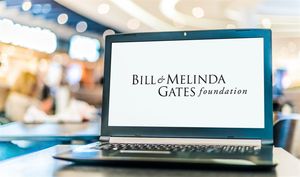
New York, NY – August 12, 2025 – Wall Street erupted in a wave of optimism today, propelling major U.S. stock indexes, including the S&P 500 and Nasdaq Composite, to unprecedented record highs. The surge was ignited by the release of the July Consumer Price Index (CPI) report, which presented a milder-than-expected headline inflation figure, significantly bolstering investor confidence in a potential interest rate cut by the Federal Reserve as early as September. This market euphoria signals a collective belief that the economy might achieve a coveted "soft landing," where inflation is tamed without triggering a severe recession.
The immediate implications of this market rally are profound, suggesting a renewed appetite for risk among investors and a strong conviction that borrowing costs are poised to decrease. While the headline inflation rate offered a sigh of relief, the slight uptick in core inflation presents a nuanced picture that the Federal Reserve will undoubtedly scrutinize. Nevertheless, for now, the prevailing sentiment is one of bullish anticipation, with market participants eagerly awaiting the Fed's next move.
Favorable Inflation Data Ignites Market Rally
The catalyst for today's historic market performance was the July CPI report, which revealed a year-over-year headline inflation rate holding steady at 2.7%, slightly below economists' expectations of 2.8%. On a monthly basis, the overall CPI rose a modest 0.2%, a deceleration from the 0.3% increase observed in June. This moderation in the headline figure, largely attributed to a decrease in energy prices, particularly gasoline, provided the crucial impetus for the market's upward trajectory.
However, the report also contained a detail that warrants closer attention: the "core" CPI, which strips out volatile food and energy prices, accelerated to 3.1% year-over-year in July, up from 2.9% in June. This marked the highest core inflation rate in six months and was slightly above the anticipated 3.0%. Despite this, the market largely chose to focus on the more favorable headline number and a weakening labor market, interpreting these as signals that the Federal Reserve (the Fed) now has greater flexibility to ease its monetary policy.
The timeline leading up to this moment has been characterized by persistent inflation concerns and a hawkish stance from the Fed. For months, the central bank has maintained higher interest rates to combat inflationary pressures. However, with recent economic data, including this CPI report, showing signs of cooling, the narrative has shifted. Key players involved in this unfolding scenario include the Federal Reserve, whose policy decisions directly impact borrowing costs and market liquidity, and investors, who are now aggressively pricing in a September rate cut. According to the CME Group's FedWatch tool, the probability of a quarter-point rate cut in September surged to nearly 95% after the report, up from approximately 86% the previous day. This initial market reaction saw broad gains across all major indexes, with technology and growth stocks leading the charge, reflecting the anticipation of lower borrowing costs which typically benefit these sectors.
Winners and Losers in a Lower Rate Environment
The prospect of lower interest rates, spurred by the latest inflation data, is poised to create a clear delineation of winners and losers across the financial markets. Companies that thrive on cheaper capital and increased consumer spending are set to benefit significantly, while others may see their relative attractiveness diminish.
Leading the charge among the winners are growth stocks, particularly those in the technology sector. Companies like Microsoft (NASDAQ: MSFT), with its robust cloud computing (Azure) and AI infrastructure, and Amazon (NASDAQ: AMZN), positioned to capitalize on increased consumer spending through its e-commerce and AWS segments, are expected to see continued strong performance. Lower borrowing costs reduce the discount rate applied to their future cash flows, making their distant earnings more valuable in present terms. Similarly, Apple (NASDAQ: AAPL) has already demonstrated strong performance, driven by strategic investment plans and favorable trade policies, and is likely to maintain its momentum.
The consumer discretionary sector is another significant beneficiary. As borrowing costs for consumers decrease, disposable income tends to rise, leading to increased spending on non-essential goods and services. Companies such as Carnival (NYSE: CCL), which has shown strong performance attributed to improved analyst sentiment and earnings outlook, and retailers like Williams-Sonoma (NYSE: WSM) and Tapestry (NYSE: TPR), are well-positioned to capitalize on this trend. Furthermore, Real Estate Investment Trusts (REITs) stand to gain considerably. Lower interest rates reduce their borrowing costs for property acquisitions and developments, making it easier to refinance existing debt. Welltower (NYSE: WELL), a senior housing specialist, and EPR Properties (NYSE: EPR), an experiential REIT, are examples of companies that could see significant upside.
Conversely, while the overall market sentiment is positive, some sectors may experience less benefit or even face relative headwinds. Value stocks, while potentially seeing an uptick from broader economic activity, generally tend to underperform growth stocks in low interest rate environments. Defensive sectors, such as consumer staples and utilities, which are typically seen as safe havens during uncertainty, might become relatively less attractive as investors shift towards higher-growth, more cyclical opportunities in a "risk-on" environment. Additionally, companies with already high valuations and expectations, such as Cardinal Health (NYSE: CAH), may face pressure if they fail to meet exceptionally high market expectations, even if their profits are strong.
Industry Impact and Broader Implications
The recent surge on Wall Street, driven by favorable inflation data and the anticipation of Federal Reserve interest rate cuts, is poised to have far-reaching industry impacts and broader economic implications. This rally reflects a growing investor optimism for a "soft landing" scenario, where inflation is successfully brought under control without triggering a severe recession, thereby fostering a more favorable environment for corporate earnings and overall economic growth.
One of the most significant broader industry trends is the continued dominance and investment in the technology sector, particularly in areas like artificial intelligence (AI). Mega-cap technology companies are not only major drivers of this surge but also significant beneficiaries, attracting substantial investment and talent due to their perceived resilience to economic cycles and capacity for consistent growth. This trend could lead to further concentration of market capitalization within the tech sector, intensifying competitive pressure on smaller players to innovate and demonstrate strong growth. Companies that fail to adapt to technological advancements or diversify their supply chains may find themselves at a disadvantage.
The ripple effects extend to various sectors and their partners. Industries heavily reliant on debt, such as real estate and homebuilders, are expected to benefit significantly from cheaper borrowing costs, potentially stimulating new projects and sales. Furthermore, the buoyant market instills confidence, leading to increased capital flows and a shift in risk appetite. This could make it easier for smaller, emerging companies to raise capital, potentially fueling further innovation and competition across industries. However, the immense resources of market leaders, especially in tech, could also intensify pressure on competitors, potentially leading to further industry consolidation. For instance, semiconductor manufacturers like Taiwan Semiconductor Manufacturing Company (NYSE: TSM) could see sustained demand from tech giants expanding operations.
From a regulatory and policy standpoint, a booming stock market might reduce the immediate pressure on policymakers for aggressive stimulus measures. However, the increasing market concentration, particularly within the technology sector, could eventually draw greater scrutiny regarding antitrust concerns and market power. Policymakers may examine whether such concentration stifles competition and innovation in the long run. The Federal Reserve's monetary policy decisions, influenced by incoming economic data, will continue to have far-reaching consequences for interest rates, corporate borrowing costs, and consumer spending. The presence of tariffs, as noted in the CPI report, can complicate the Fed's decision-making by potentially pushing prices higher, even as other inflation measures cool. Historically, Fed rate cuts have often preceded significant stock market gains, with the S&P 500 averaging substantial returns in the 12 months following the first rate cut in "soft landing" scenarios. However, it's important to note that volatility has historically been above average in the months surrounding the first rate cut, highlighting that these cycles are associated with increased uncertainty.
What Comes Next
The recent surge on Wall Street, driven by favorable inflation data and the anticipation of Federal Reserve interest rate cuts, sets the stage for a dynamic period ahead. While short-term optimism abounds, the path forward presents a mix of possibilities and challenges that will require strategic adaptation from investors and businesses alike.
In the short term, the market is largely pricing in a September rate cut, with probabilities hovering around 90-94%. This expectation is fueled by the July CPI report, which showed a year-over-year inflation rate of 2.7%, slightly below forecasts. Lower rates are anticipated to stimulate borrowing and investment, thereby boosting asset prices and the broader economy. Corporate earnings estimates for the S&P 500 remain favorable, with projected double-digit increases in 2025 and 2026, largely driven by the technology and communication services sectors benefiting from AI investments. However, a divergence in expectations exists, with some major Wall Street banks, including Bank of America and Morgan Stanley, not anticipating any Fed rate cuts until at least 2026, citing sticky inflation and labor market dynamics. This could lead to short-term volatility as the market grapples with conflicting signals.
Looking further out, the long-term outlook remains generally positive, though with expected volatility. Global economic growth is projected to maintain a steady pace, with the U.S. continuing to drive global growth. Key long-term drivers include continued technological innovation, particularly in Artificial Intelligence (AI), and the energy transition. However, geopolitical risks, ongoing trade tensions, and policy uncertainty are expected to contribute to increased macroeconomic volatility in the second half of 2025. Businesses will need to focus on adaptive financial planning, cost control, and strengthening supply chain resilience. Investors, meanwhile, may need to adopt a more selective approach to sectors, aligning with the current policy environment and economic trends, rather than relying on broad market growth.
Market opportunities are abundant in sectors like Artificial Intelligence & Automation, Energy Transition & Critical Minerals, and Healthcare Innovation & Longevity Science. Cybersecurity and Digital Resilience also present significant growth avenues given rising geopolitical risks. Conversely, challenges include the potential for persistent inflation, particularly influenced by tariffs, and the uncertainty surrounding the Federal Reserve's policy decisions. High market valuations also increase pressure on companies to sustain profit growth, and ongoing geopolitical risks could threaten global trade and market stability. The coming months will be critical, with investors closely monitoring inflation data, Fed rhetoric, and developments in global trade relations to gauge the most likely trajectory for Wall Street and the economy.
Conclusion
The recent surge on Wall Street, propelled by favorable inflation data and the heightened anticipation of Federal Reserve interest rate cuts, marks a pivotal moment for the financial markets. The key takeaway is a renewed sense of optimism among investors, who are increasingly betting on a "soft landing" for the economy – a scenario where inflation is successfully managed without triggering a severe recession. This sentiment has driven major U.S. stock indexes to new record highs, signaling a strong belief in the potential for lower borrowing costs to stimulate economic activity and corporate profitability.
Moving forward, the market will remain highly sensitive to incoming economic data and the Federal Reserve's communications. While the July CPI report provided a much-needed dose of confidence, the slight increase in core inflation serves as a reminder that inflationary pressures are not entirely subdued. Investors should closely watch for further inflation reports, labor market data, and any shifts in the Fed's rhetoric, as these will be crucial in determining the timing and magnitude of potential rate cuts. The performance of growth stocks, particularly in the technology sector, will be a key indicator of market sentiment, as these companies tend to thrive in a lower interest rate environment.
The lasting impact of this event could be a recalibration of market expectations, moving from a period of aggressive rate hikes to one of potential easing. This shift could foster a more favorable environment for long-term investment and economic expansion. However, the path ahead is not without its challenges, including persistent inflation risks, geopolitical uncertainties, and the potential for market volatility. Investors should prioritize diversification, conduct thorough due diligence, and maintain a long-term perspective to navigate the evolving landscape. The coming months will reveal whether the current optimism translates into sustained economic growth and a truly soft landing, or if unforeseen headwinds emerge to temper the market's current enthusiasm.






